Have you ever Googled a doctor and wondered why some clinics pop up right away while others are buried five pages deep? That’s the magic (or the mess) of healthcare SEO.
It’s basically how healthcare providers get found online – without paying for ads. If someone’s searching for “best urgent care near me,” you want your name to be right there at the top of the search engine results pages. It’s not halfway down page three.
But here’s the thing: SEO in the healthcare industry isn’t like selling sneakers or skincare. It’s about trust. People aren’t just clicking – they’re choosing someone to take care of their health. That’s a big deal.
That’s why having a solid healthcare SEO strategy matters. It helps you show up, look legit, and connect with patients before they even walk through your door. And with the right local SEO setup? You’re not just online – you’re everywhere your future patients are searching.
Core Strategies for Healthcare SEO Success
Getting your website to rank isn’t just about stuffing it with keywords – it’s about building a smart, patient-first SEO strategy that actually works. Whether you’re running a small private clinic or managing marketing for one of the larger healthcare companies, the right approach to search engine optimization makes all the difference.
The Three Pillars of SEO: On-Page, Off-Page & Technical SEO

When we talk about SEO strategy, we’re really talking about three main building blocks. These work together to boost your site’s visibility, traffic, and trust online.
| SEO Pillar | What It Means for Healthcare Companies | Why It Matters |
| On-Page SEO | Optimizing content, keywords, service pages, meta tags, and headers | Helps search engines understand your services |
| Off-Page SEO | Building backlinks from trusted sources, health directories, and PR mentions | Builds your authority and online credibility |
| Technical SEO | Improving page speed, mobile performance, and site structure | Keeps your site functional and easy to navigate |
Nailing all three pillars is key to standing out in an increasingly crowded digital space, especially for healthcare organizations.
Aligning SEO with Your Healthcare Business Goals
A cookie-cutter healthcare SEO strategy won’t cut it. You need a plan that actually supports your business goals – whether that’s attracting new patients, opening new locations, or growing online referrals.
Here’s how you can tailor your approach:
- Want to attract local patients? Double down on Google Business Profile optimization, review management, and local SEO tactics.
- Expanding services or specialties? Create detailed service pages and blog content that match what people are already searching for.
- Looking to grow brand awareness? Consider working with a reputable healthcare SEO agency that understands the unique challenges of the healthcare industry and can provide proven healthcare SEO services.
Optimizing for Patient Experience & Conversion
Traffic is significant, but conversions? That’s where the magic happens. You want site visitors to become actual patients – and that means creating a seamless, trustworthy experience.
Here’s what to focus on:
- Smooth navigation. Patients should find key information – locations, hours, and contact details – in just a few clicks.
- Strong calls-to-action. Make the “Book Now” and “Call Today” buttons clear and visible.
- Mobile-first design. Most users visit on their phones. If your site isn’t mobile-friendly, that’s a deal-breaker.
- Write for humans. Use friendly, helpful language. Show empathy. It’s healthcare, after all.
The best SEO efforts don’t just drive traffic – they guide people through a helpful, trustworthy journey that ends with a scheduled appointment.
Local SEO: How to Dominate Local Search Results
Let’s be real – when people need a doctor, they’re not searching for a “general healthcare provider.” If you’re in a specialized field like dental care, this SEO for dentists guide covers niche-specific tactics that improve visibility in highly localized search results.
They’re typing in stuff like “urgent care near me” or “best dentist in [city].” That’s why local SEO is a game-changer for healthcare providers and healthcare companies alike.
Local optimization is essential if you want to appear when patients search in your area.
Claiming and Optimizing Google Business Profile and Acquiring Local Citations & NAP Consistency

If you want more patients to actually find your practice online, one of the easiest things you can do is set up your Google Business Profile – you know, that little box that pops up when you search for a local place on Google Maps or Search.
When it’s done right, it can appear at the top of the page. For example, if someone types in “Cardiologist in California,” they’ll see a map with clinics nearby – and your profile could be one of them.
It’s super visible and shows all the good stuff, like your hours, reviews, and how to get in touch.
First things first: create or claim your profile (if someone else hasn’t already set it up). Not sure how? There’s a guide for that – it’s easier than it sounds.
Then, make it work harder for you by:
- Adding your name, address, phone, website, and hours (don’t skip anything)
- Picking the right category that fits your clinic
- Uploading nice photos of your space – people love visuals
- Using keywords that make sense for what you offer
Also, make sure your info (especially name, address, and phone number) matches across other sites like Yelp. That consistency helps you show up better in local search.
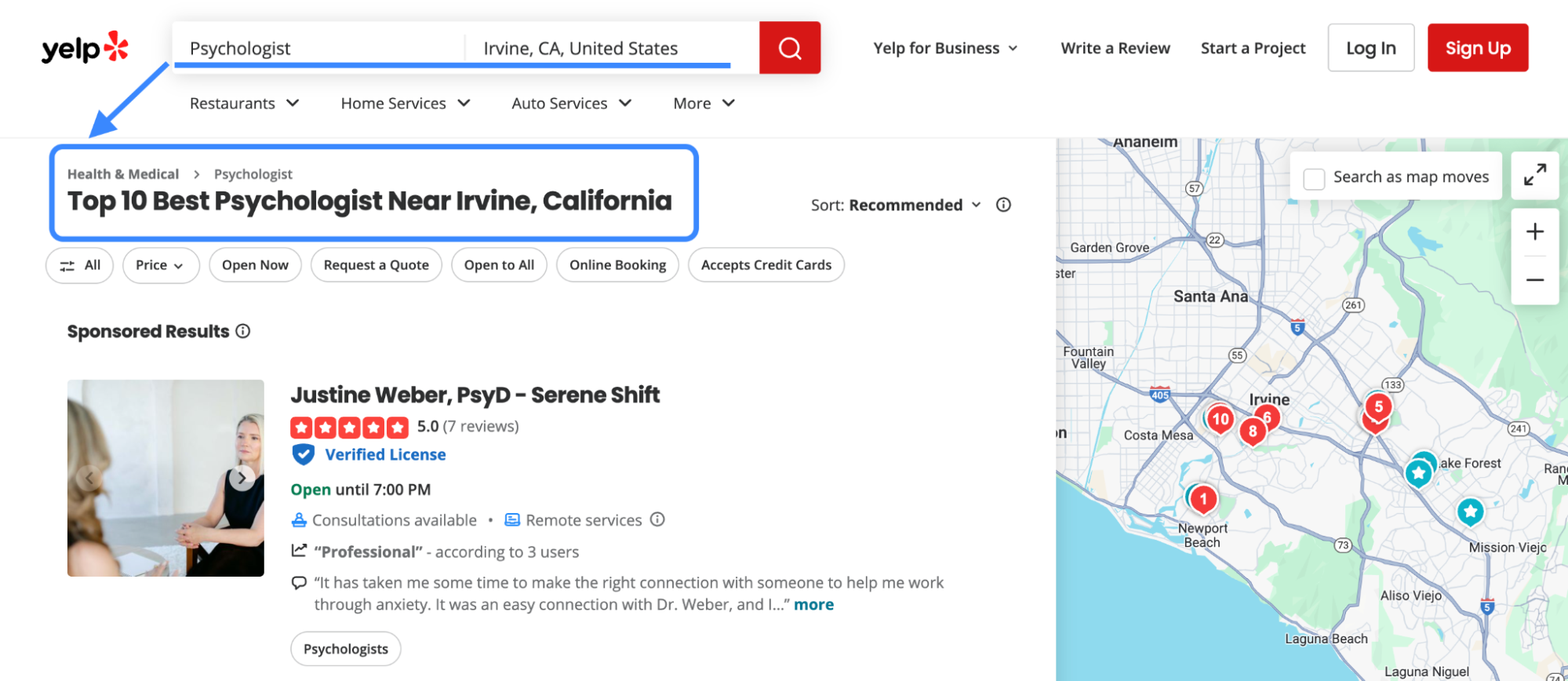
Basically, it’s like giving Google all the right signals so your clinic pops up when someone nearby is looking for help.
Leveraging Patient Reviews & Reputation Management
Online reviews aren’t just for restaurants. Patients rely on them to choose their next provider. Plus, reviews actually influence your rankings on search engine results pages.
How to make it work for you:
- Ask happy patients to leave reviews on Google, Yelp, and health-specific platforms
- Respond to every review – good or bad – with professionalism and empathy.
- Use reviews as content: feature them on your site, in testimonials, or social posts.
Pro tip: The more quality reviews you have, the stronger your local SEO presence.
Building Local Landing Pages for Multiple Locations
If you have more than one clinic or office, don’t list addresses on a single page – give each location its own page.
What to include:
- Location-specific keywords (e.g., “dermatologist in Pasadena”)
- Unique content about each office’s team, services, hours, and parking info
- Embedded Google Maps and clickable directions
This not only improves SEO but also makes life easier for your patients.
Using Geo-Specific Keywords to Attract Local Patients
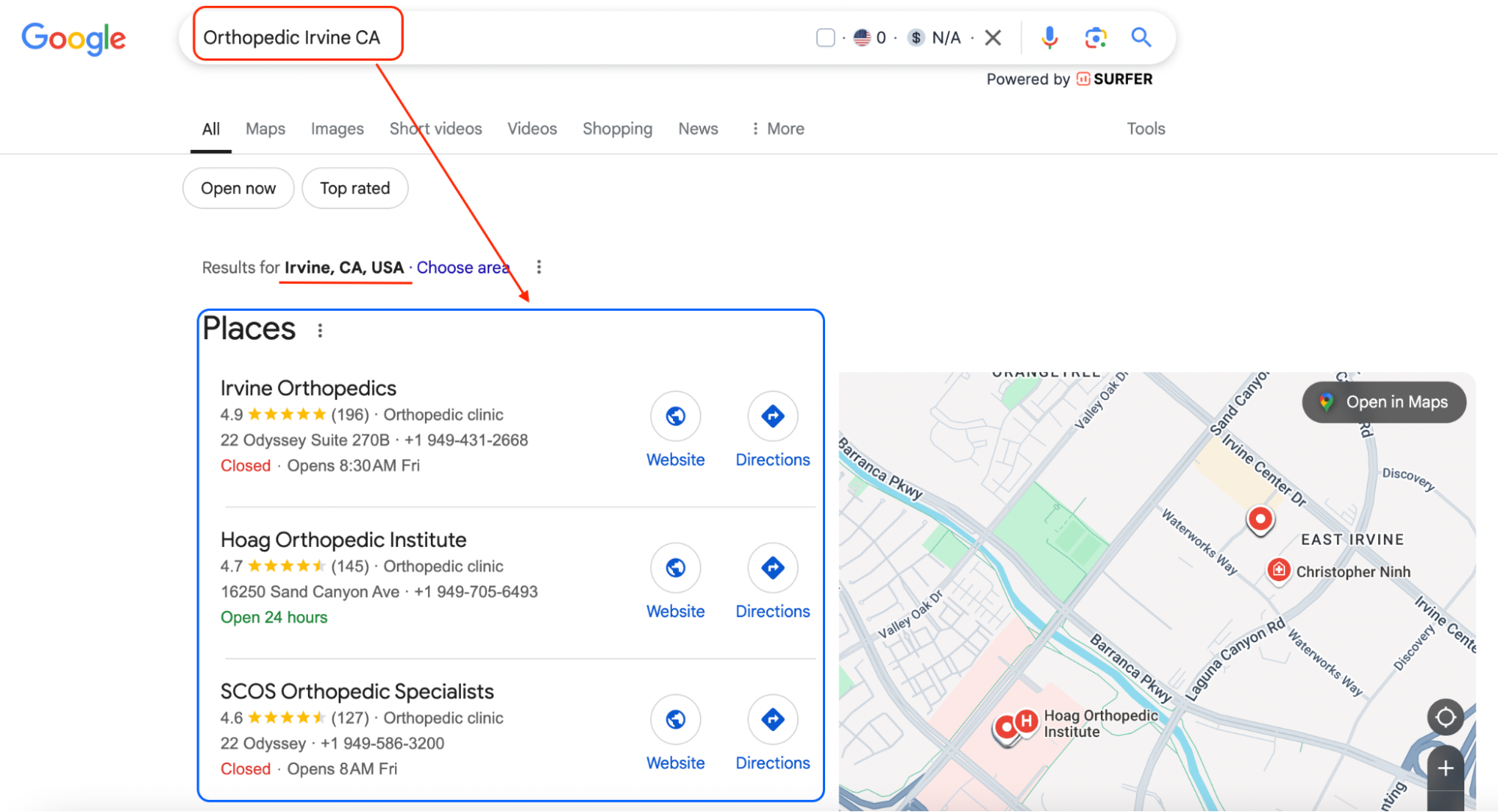
Finally, make sure your site content speaks the local language – literally. Use geo-specific keywords that match what people in your area are actually typing.
Try phrases like:
- “pediatric urgent care in [city]”
- “walk-in clinic near [neighborhood]”
- “flu shot in [zip code]”
Integrating these into your content, meta descriptions, and headers gives healthcare organizations a significant edge in local search.
Keyword Research for Healthcare Websites
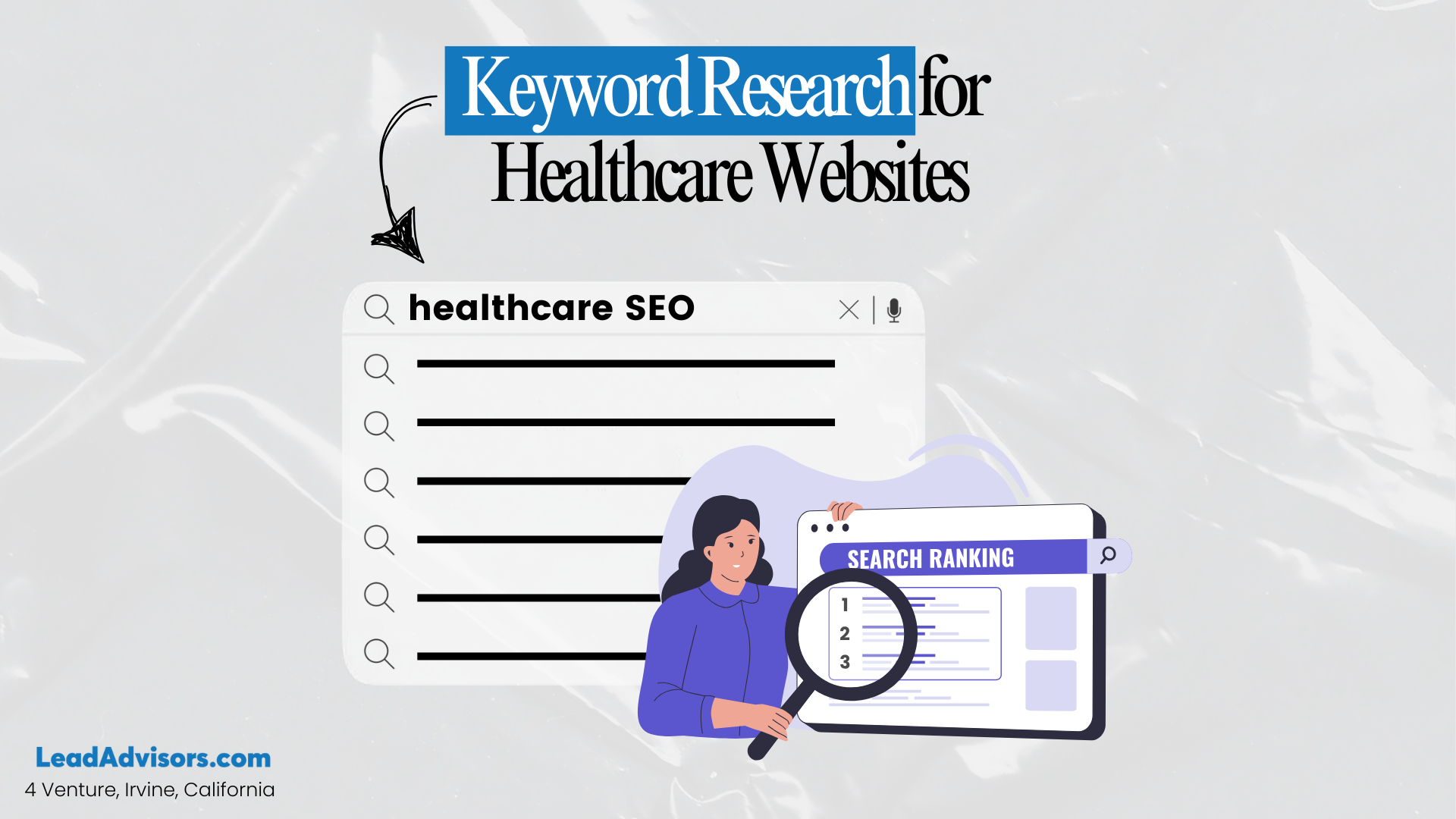
Let’s be real – ranking on search engines starts with using the right words. And not just any words, but the exact phrases your future patients are typing into Google. That’s where keyword research comes in, and it’s one of the most underrated power moves in healthcare SEO.
Understanding Patient Search Intent: Informational, Navigational, Transactional
Before you even start typing keywords into a tool, you need to think like a patient. What are they looking for? Why are they searching?
There are three main types of search intent:
- Informational: “What causes knee pain?” or “How to lower blood pressure naturally”
- Navigational: “Kaiser Permanente urgent care login” or “UCLA Health portal”
- Transactional: “Book dermatologist appointment near me” or “Urgent care open now”
A strong SEO strategy targets all three – building trust, guiding patients to your site, and getting them to book appointments.
Long-Tail vs. Short-Tail Keywords for Healthcare SEO
Let’s break this down real quick:
- Short-tail keywords are broad: “dermatologist,” “flu shot”
- Long-tail keywords are specific: “affordable dermatologist for acne in Pasadena”
Sure, short-tail terms get more search volume – but they’re also more challenging to rank for and often less targeted.
Long-tail keywords may get fewer hits, but they attract people who are ready to take action. Not sure how they compare to other keyword types? Here’s a breakdown of types of keywords in SEO and when to use them effectively. In the world of healthcare companies, long-tail keywords are often where the real SEO wins happen.
Finding Low-Competition Keywords to Outrank Major Competitors

Here’s a secret: You don’t have to compete head-to-head with big hospital networks on every keyword. Instead, look for low-competition, high-intent terms that match what your ideal patient is searching for.
Many SEO strategies begin by focusing on long-tail keywords with lower difficulty to bypass high competition. As results start to appear, the approach gradually shifts toward more competitive terms.
For example, the keyword “toothache” has a Keyword Difficulty score of 78, labeled “super hard.” Ranking in the top 10 would require backlinks from approximately 310 referring domains. Despite its high search volume of 40K in the United States and 111K globally, this keyword is highly competitive.
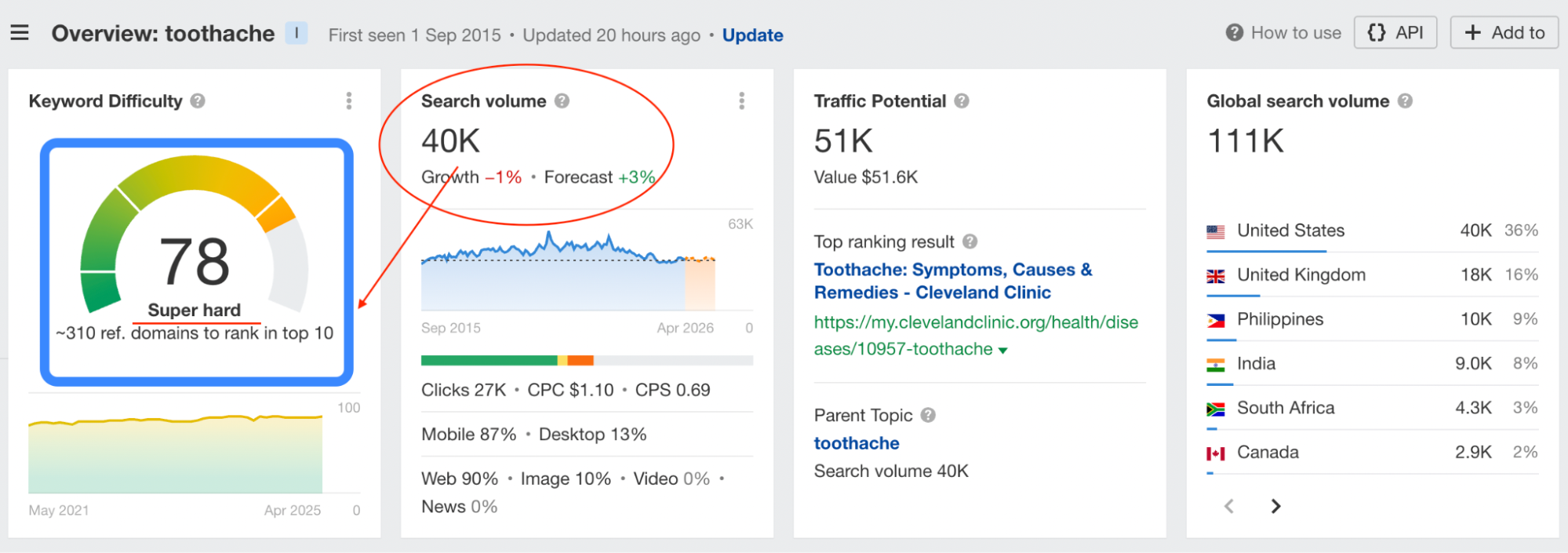
Instead of directly targeting such broad terms, tools like Ahrefs’ Keywords Explorer can help discover related keywords with lower difficulty.
Take a look at what I did here. I filtered the Keyword Difficulty by a maximum of 40, which helped me surface hundreds of keyword opportunities that are easier to rank for.
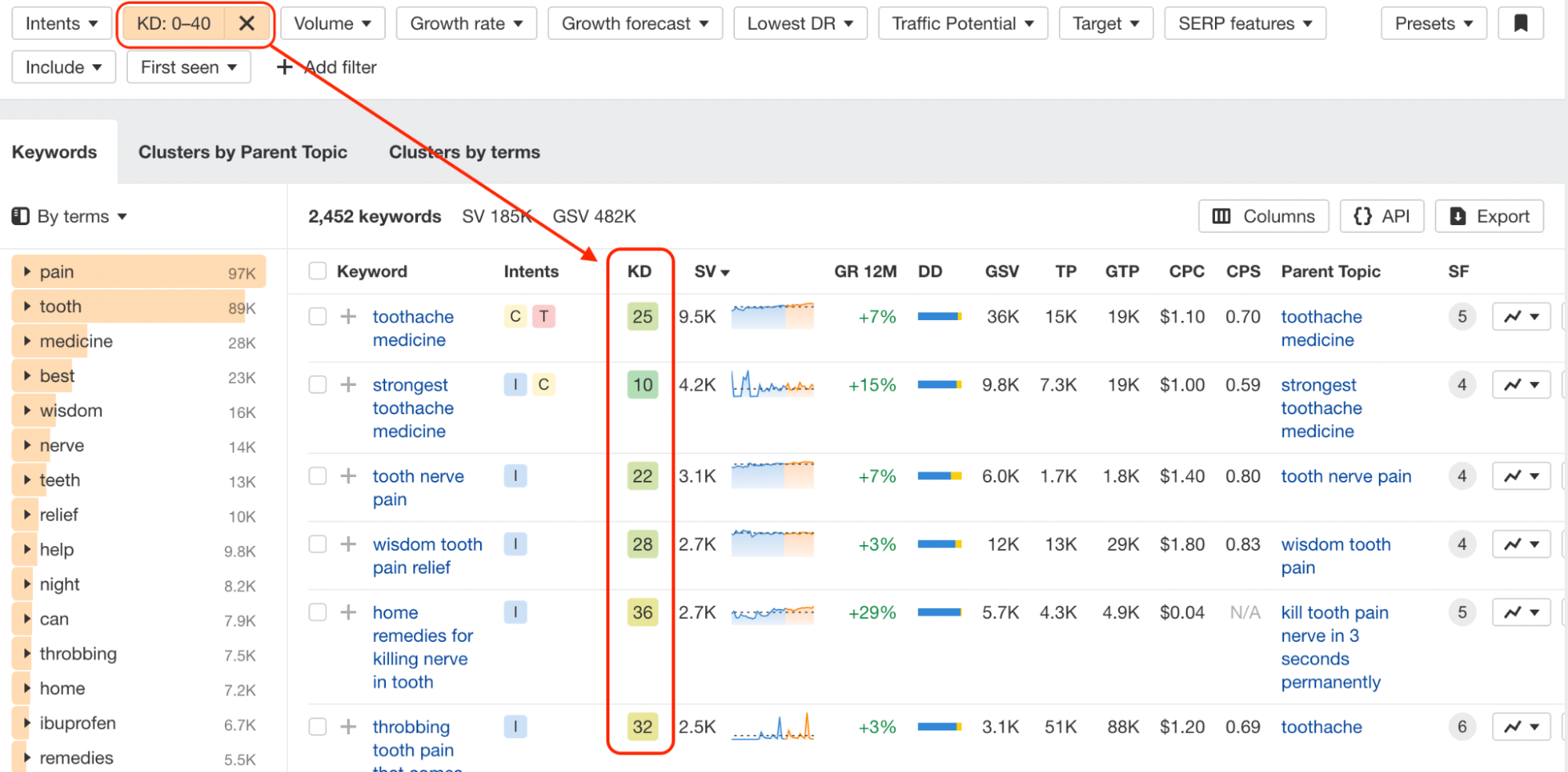
For even better ranking potential, applying a Domain Rating (DR) filter (e.g., DR < 30) will reveal keywords where low-authority websites already appear in the top search results – indicating strong potential for newer or smaller websites to compete effectively.
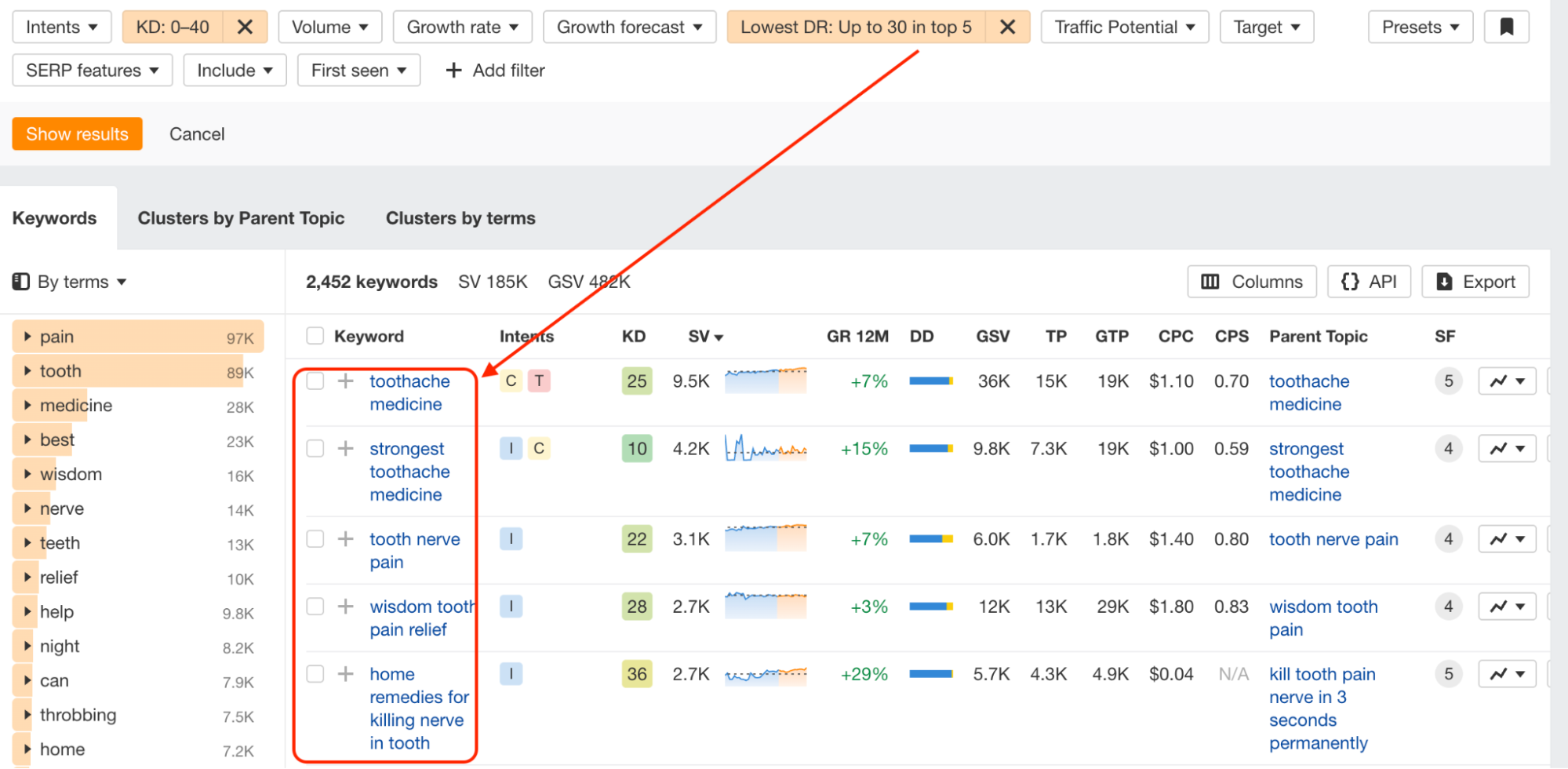
This is where working with a healthcare SEO agency can be a game-changer. Many offer access to advanced healthcare SEO services that help you identify hidden keyword opportunities your competitors are missing.
SEO Tools for Keyword Research
You don’t have to guess what people are searching for. These tools help you get data-driven insights:
| Tool | What It Does |
| Google Keyword Planner | Great for basic search volume and keyword ideas (free with a Google Ads account) |
| Ahrefs | In-depth data on competitors, keyword difficulty, backlinks, and content gaps |
| SEMrush | Full-service SEO suite with tools for tracking rankings and performing audits |
| Moz | User-friendly option for keyword research, site tracking, and SEO insights |
Pro tip: Combine these tools to find that sweet spot between keyword relevance, volume, and competition.
Using Question-Based Keywords & Voice Search Optimization
People are searching with questions more than ever – especially with voice assistants like Siri, Alexa, and Google. So it’s smart to optimize for the way people actually talk.
Try question-based keywords like:
- “Where can I get a walk-in flu shot?”
- “How long does pink eye last?”
- “Who should I see for lower back pain?”
Use these naturally in your blog posts, FAQs, and service pages to show up for voice queries and featured snippets.
Content Marketing & Medical SEO: Creating Patient-Centric Content
When it comes to healthcare SEO, content isn’t just king – it’s the entire kingdom. Patients want answers, guidance, and reassurance, and it’s your content that builds trust long before they step into your clinic.
But not just any content will do. In the healthcare industry, you have to balance clarity with credibility while keeping things compliant.
Google’s E-E-A-T: What It Means for Healthcare Sites

Google doesn’t just rank content based on keywords – it evaluates who is creating it. That’s where E-E-A-T comes in:
- Expertise – Are you qualified to talk about this topic?
- Experience – Have you (or someone qualified) actually lived or practiced it?
- Authoritativeness – Are others citing or linking to your content?
- Trustworthiness – Is your info accurate, safe, and updated?
For healthcare organizations and companies, demonstrating E-E-A-T is non-negotiable. Google sees medical topics as YMYL (Your Money or Your Life) content, so your pages need to be fact-checked, reviewed, and written by credible voices.
Take a look at this example,
Cleveland Clinic includes a “medically reviewed” badge, and links to a list of editorial standards:
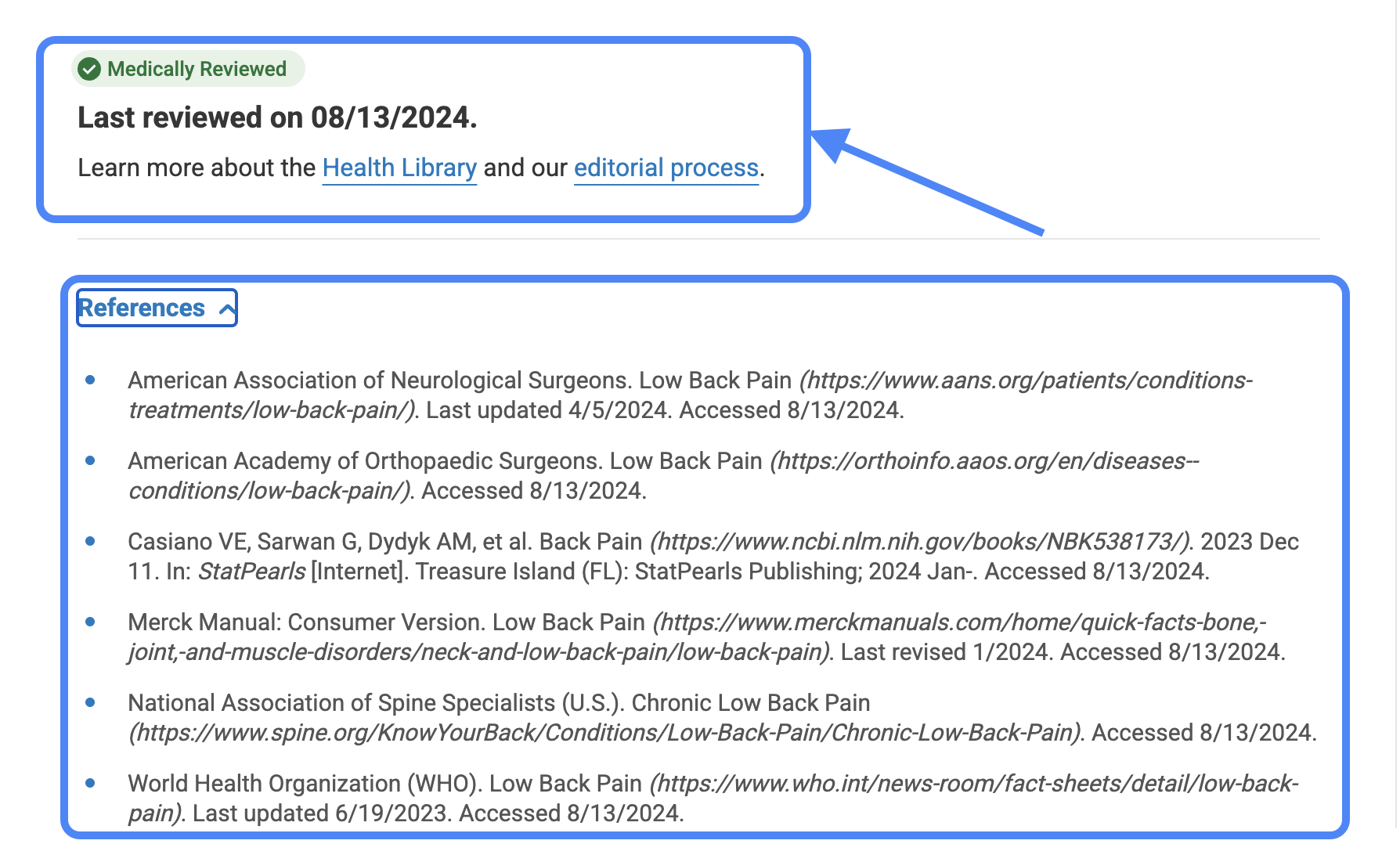
How to Structure Content for Healthcare Websites
Your website’s structure helps search engines and patients navigate your content easily. Here’s a quick checklist:
- Use H1, H2, H3 tags to break up sections
- Add internal links between related topics and services.
- Organize your content into SEO silos to strengthen topical relevance and improve crawlability.
- Include CTAs like “Book Now” or “Call for an Appointment”
- Highlight credentials or include author bios for medical articles.
A clean structure isn’t just good SEO – it’s a better experience for real people.
Optimizing Blog Content for Featured Snippets & FAQs
Want to be the first answer Google shows in a featured snippet? Structure your content like a quick Q&A. Think:
Q: What causes migraines?
A: Migraines can be caused by stress, hormonal changes, certain foods, or environmental factors.
To maximize visibility, use bullet points, tables, and FAQs at the bottom of your posts. This also helps with voice search!
Content Types That Drive Traffic & Engagement
Not all content works the same way. Here’s what really resonates in the healthcare SEO world:
- Blog Posts & Evergreen Guides
Explain conditions, treatments, and prevention in an easy-to-understand way.
Ex: “10 Things to Know About High Blood Pressure” - Patient Education Content
Answer questions patients are afraid to ask during appointments. - Medical Research & Whitepapers
Great for B2B-facing healthcare companies and practices with specialized expertise. - Case Studies & Patient Testimonials
Real stories build credibility and trust – plus, they convert like crazy. - Videos & Visual Content
Infographics, explainers, and short animations help simplify complex medical topics and boost time on site.
Medically Reviewed Content: Best Practices & Compliance
If you’re producing medical content, it needs to be accurate, updated, and reviewed by licensed healthcare professionals.
Follow these best practices to stay compliant with YMYL (Your Money or Your Life) guidelines:
- Add a “Medically Reviewed by” section with credentials

- Include date stamps for content freshness.
- Avoid unverified health claims – back everything up with sources.
- Partner with a healthcare SEO agency that understands compliance requirements
Creating trustworthy, patient-centric content is more than just a marketing strategy – it’s how your site earns real visibility and builds long-term authority online.
Technical SEO for Medical Websites

You could have the best blog posts and the perfect keywords – but if your site loads like it’s stuck in 2008 or gives patients a security warning, none of it matters. Technical SEO is what makes sure your entire website works smoothly, both for patients and for search engines.
Speed & Mobile Optimization: Your First Impression
Nobody waits for a slow website – especially not someone trying to book a same-day appointment. Your webpage should load in under 3 seconds and be easy to navigate on any device. In healthcare marketing, this is the digital equivalent of having a clean, well-organized waiting room.
Schema Markup: Speak Google’s Language
Think of schema markup like labels on a file folder – it helps search engines understand precisely what’s on your site. Adding medical-specific schema (like provider names, specialties, and locations) makes your listings more clickable and increases your chance of showing up in rich results.
| Without Schema | With Schema |
| Just a plain search listing | Enhanced listing with ratings, hours, and services |
| Less context for Google | Clear data on doctors, departments, and specialties |
Security & Compliance: More Than Just a Lock Icon
Patients want to feel safe when visiting your site – and so does Google. That means HTTPS encryption is a must. And if you’re collecting any personal health information (even through a contact form), HIPAA compliance needs to be part of your technical checklist.
A secure site supports trust, which is foundational in any medical search engine optimization strategy.
Crawling & Indexing: Help Google Find (and Trust) Your Pages
Your site’s architecture should make it easy for search engines to navigate. That means using internal links wisely, organizing content logically (like services under specialties), and submitting an updated sitemap.
When done right, this supports both visibility and user experience – two essentials in modern healthcare marketing.
“If Google can’t find it, patients can’t either.”
Clean Up the Errors
Broken links, 404 pages, and messy redirects send the wrong signals to both users and algorithms. Regular site audits will help you catch these issues early.
Even small fixes can have a noticeable impact on your site’s performance and rankings in medical-related searches.
Building Authority with Off-Page SEO
Let’s say your website looks great, loads fast, and your content is solid. Now what? If no one’s linking to your site, search engine algorithms may still overlook you. That’s where off-page SEO comes in – it’s your credibility builder, showing search engines and patients that others trust your medical practice in the industry.
High-Quality Backlinks from Medical & Health Authorities
Backlinks play a major role in successful SEO strategies – and that holds especially true for healthcare SEO.
If the thought of doing “shady” outreach makes you uneasy, you’re not alone. The good news? Healthcare companies are actually well-positioned to build high-quality backlinks without resorting to questionable tactics.
Thanks to their strong ties with government agencies, nonprofits, and educational institutions, many healthcare organizations can earn backlinks from high-authority .gov and .edu domains. To expand on this, explore proven local link-building strategies designed to help smaller clinics and regional providers grow authority organically.
For example, Despina highlighted HammondCare, an aged care provider in Australia. Their backlink profile shows 33 referring domains from .gov sites – and 24 more from .edu sources.
Referring to domains from “.gov”
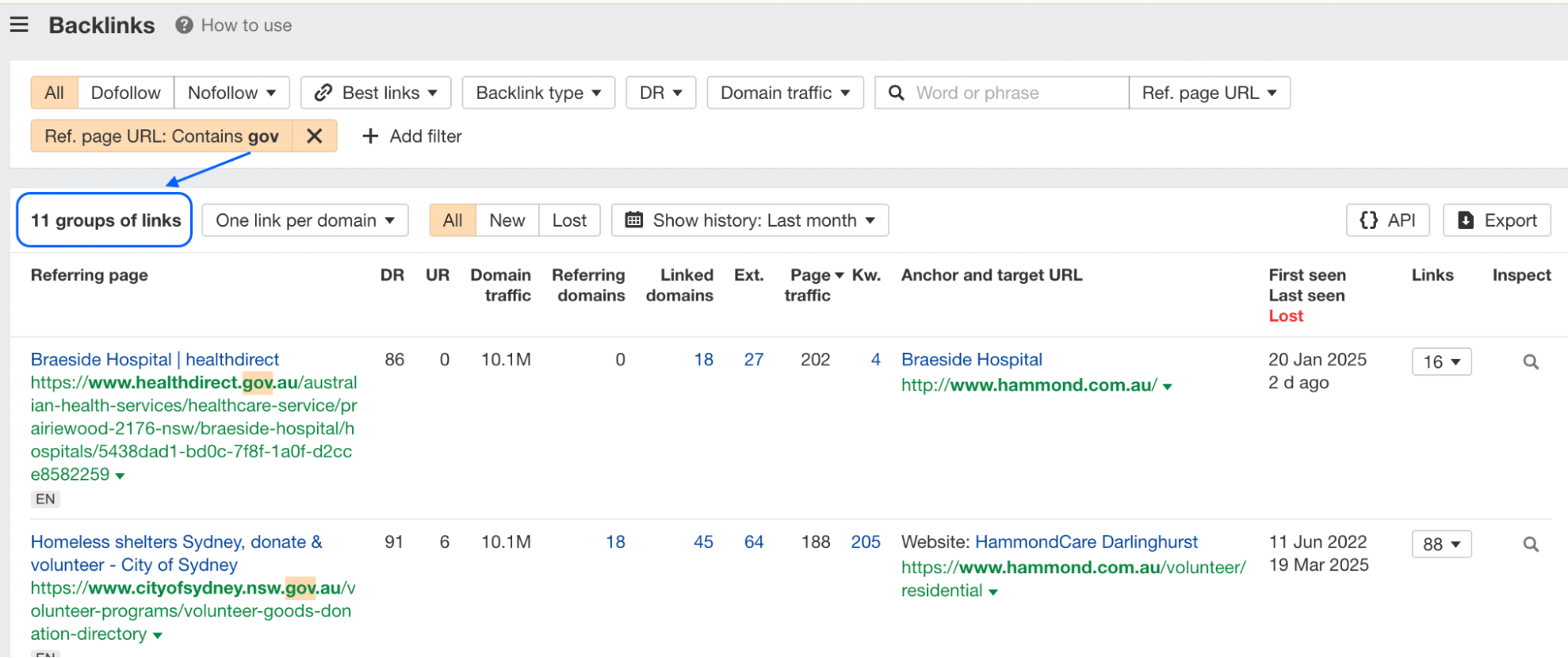
Referring domains from “.edu”
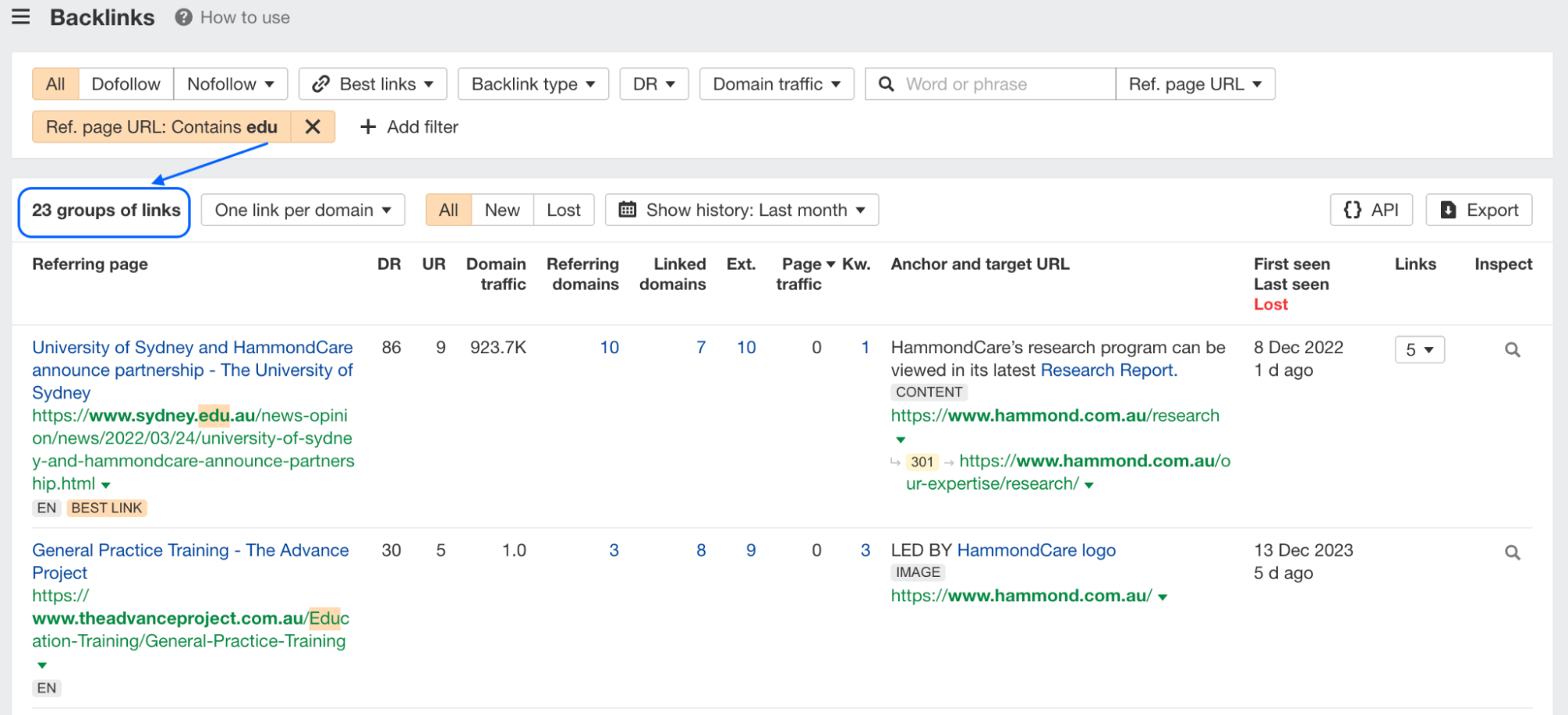
Government &.EDU Links: The Ultimate Authority Boost
When it comes to boosting authority fast, .gov and .edu links are some of the most powerful in the game.
| Source | Example Opportunity | SEO Benefit |
| .gov | Public health directories or state registries | Trusted by Google, strengthens your search rankings |
| .edu | University citations in research or health partnerships | Signals academic-level credibility |
| Accreditation sites | Listings from bodies like the Joint Commission | Validates your medical practice as certified and compliant |
Being referenced by government or educational sites doesn’t just improve trust – it’s a fast track to better visibility.
Collaborating with Medical Associations & Industry Publications
Partnering with well-known medical associations (like AMA or AHA) or contributing to industry-leading publications gives your SEO efforts a significant credibility bump.
Whether you’re offering expert commentary in a journal, co-authoring a thought leadership piece, or getting mentioned in an association newsletter, these mentions build authority – both in the real world and in search rankings.
It’s one of the most sustainable ways to grow your medical practice’s reputation online.
Editorial Evergreen Content That Attracts Backlinks
Evergreen content is your passive link-builder – it keeps working long after it’s published.
Take this explainer on endocrinology or this guide on immunization tracking. These resources are detailed, valuable, and link-worthy.
When your healthcare marketing team creates high-value guides, listicles, or case studies, you’re not only helping patients – you’re inviting backlinks, which steadily improve your search rankings.
How Affiliate Editorial Reviews Support Medical SEO

Affiliate editorial reviews are content-based placements on high-authority news and healthcare platforms. They’re sponsored, but they’re written to inform, not just sell.
They help your brand stand out in search and improve visibility through natural backlinking.
Take these real examples:
- Spectrum Eval Experience – Reviews from Professionals
- SentryMD – Healthcare Compliance Review
These reviews provide a trusted source of information while driving authority and conversion traffic – two powerful components of medical search engine optimization.
Avoiding Spammy SEO Tactics
Now for a word of caution: not all backlinks are good backlinks.
Tactics like buying links, joining link schemes, or spamming directories can backfire. In fact, they may hurt your visibility once search engine algorithms catch on.
Instead, focus on earned media – organic mentions, genuine collaborations, and long-term relationships that reflect the credibility of your medical practice.
If the link wouldn’t make sense to a real patient, it won’t make sense to Google either.
SEO Analytics & Performance Tracking
You can’t improve what you don’t measure – and that goes double for your medical practice’s online visibility. The beauty of medical search engine optimization is that everything is trackable. You’re never guessing – you’re looking at data that tells you what’s working, what’s not, and what to fix next.
What Metrics Actually Matter?
Not all SEO metrics are created equal. Vanity stats like “page views” might look nice, but they don’t always reflect progress. The metrics that really move the needle in healthcare marketing are the ones that connect directly to patient behavior and intent.
Here’s what to watch:
- Organic traffic: Are more people finding your site through search engines?
- Keyword positions: Are your key pages moving up in the search rankings?
- Bounce rate & time on site: Are visitors staying long enough to engage with your content?
- Goal completions: Are they booking, calling, or filling out contact forms?
It’s less about clicks – and more about conversions.
Google Analytics vs. Google Search Console
Think of Google Analytics as your internal data view – it shows how visitors behave once they land on your site. Are they reading your blog, clicking “Book Now,” or bouncing off the homepage?
On the flip side, Google Search Console is like your SEO command center. It tells you:
- Which queries are triggering impressions
- What your average position is in the search rankings
- How often your pages are being indexed
- What errors might be holding you back from Google’s good graces
Together, they give you a complete picture – from the first click to the final action.
Measuring Conversions That Actually Matter
Traffic is nice, but traffic that converts into appointments is what really counts.
Let’s say someone finds your cardiology page through a search, reads it, and books a consultation – that’s a conversion. Tracking this kind of behavior tells you exactly which keywords and pages are doing their job.
Whether it’s phone call clicks, form submissions, or online bookings, this is where your medical practice sees actual ROI from your search engine optimization efforts.
Know Where You Stand with Competitive Benchmarking

You’re not the only practice in town investing in SEO – and that’s why keeping an eye on your competitors matters.
Regular benchmarking helps answer:
- Who’s outranking you for core services like “orthopedic surgeon near me”?
- What type of content are they producing that’s earning backlinks?
- How does your site speed, authority, or backlink profile compare?
Tools like SEMrush, Ahrefs, or Moz let you track these things and shape a more informed SEO strategy that’s not just reactive – but proactive.
Time for a Check-Up: Conducting an SEO Audit
Just like you wouldn’t skip annual physicals, your website needs regular check-ups too. An SEO audit reveals technical issues, content gaps, and user experience barriers that may be silently hurting your search rankings.
At a glance, your audit should cover:
| Area | What You’re Checking | Why It Matters |
| Technical SEO | Site speed, mobile-friendliness, crawl errors | Search engines need access to your content |
| On-page SEO | Titles, headers, keywords, internal linking | Improves structure and context |
| Off-page SEO | Backlink profile, domain authority | Measures site credibility |
| Content quality | Relevance, accuracy, freshness | Aligns with search engine algorithms |
| Conversion flow | CTAs, form usability, and booking options | Affects actual patient actions |
Think of audits as your roadmap – showing exactly where to tune up your strategy next.”
Common SEO Mistakes in Healthcare & How to Avoid Them
Even the most well-meaning medical practices can fall into SEO traps that silently hold back their visibility online. The good news? Most of these missteps are easy to fix – once you know they’re there.
Let’s break down the top mistakes we see in healthcare and what you can do to stay ahead.
- “We’re not showing up locally – but we’re on Google!”
Many practices assume they’re covered because they built a website. But if you haven’t fully optimized your Google Business Profile or maintained accurate listings across directories, local patients may never see you.
When local SEO is ignored, especially in competitive cities, it’s easy to get outranked by practices with a fraction of your experience – just because they show up better in search rankings.
“If your business info is inconsistent or incomplete online, search engines don’t know when – or if – they should show you.”
- Trust-Damaging Content That Lacks Medical Review
In healthcare, content isn’t just content – it’s patient education. Publishing articles without review by a licensed professional can trigger red flags in Google’s search engine algorithms, especially in YMYL (Your Money or Your Life) categories.
If your blog post is giving advice but lacks authority, you risk losing trust with both patients and search engines. Every piece should reflect expertise and be reviewed for accuracy.
- Neglecting Site Speed and Technical Health
Here’s the quiet killer of SEO performance: a slow, glitchy website.
Patients don’t wait. And neither do bots. If your pages load too slowly or aren’t optimized for mobile, you’re handing over traffic to faster competitors. Worse, your crawlability and indexability can suffer, leaving key pages invisible to search engine algorithms.
A fast, secure, mobile-first site is no longer a bonus – it’s a baseline requirement.
- Forgetting That Reviews Are SEO
Many practices underestimate how much patient reviews influence both click-through rates and local search rankings. A 4.8-star average with fresh reviews and responses tells both Google and potential patients that your medical practice is engaged and trusted.
If you don’t actively manage your reputation, ask for reviews, or respond to them, you’re sacrificing visibility (and trust).
- Content That Never Evolves
The healthcare space is constantly changing – new guidelines, new treatments, new patient concerns. But if your website still features outdated blog posts from 2020 or keywords that no longer match current search behavior, your content will slowly drop in the rankings.
Google’s search engine algorithms reward freshness, relevance, and accuracy. Regular content audits, updates, and re-optimization aren’t just a “nice to have” – they’re essential for long-term visibility.
SEO isn’t a one-and-done effort. It’s a living part of your healthcare marketing strategy.
Future of Healthcare SEO: Trends & Predictions
Healthcare SEO is evolving rapidly, thanks to emerging technologies and changing patient behaviors. To stay competitive, medical websites must adapt to how search engines and users interact with content today.
| Trend | What It Means | Key Takeaways |
| AI & Machine Learning | Google uses AI to understand search intent better. | – Write for humans, optimize for AI – Learn how to rank in AI overviews to appear in featured search results driven by generative AI – Focus on context, not just keywords |
| Voice Search Optimization | Patients are using voice assistants for health-related queries. | – Use conversational language – Add FAQs with natural phrasing |
| Video SEO | Videos increase engagement and trust in healthcare. | – Post educational or intro videos – Optimize titles, tags, and transcripts |
| Google Algorithm Updates | Future updates will prioritize EEAT in YMYL niches like healthcare. | – Show credentials – Cite trusted sources – Keep content medically reviewed |
| Personalized Search & Patient-Focused SEO | Search results now vary by location, history, and behavior. | – Improve local SEO – Prioritize mobile UX – Address patient concerns directly |
Frequently Asked Questions
How long until I see Healthcare SEO results?
Can SEO help reach rural or underserved patients?
Does HIPAA impact my SEO strategy?
Should I use medical terms or patient-friendly language?
Can telehealth services be optimized for SEO?
Ready to Take the Guesswork Out of Healthcare SEO?
You’ve got patients to care for – let us handle the SEO. Whether you’re struggling to rank on Google, don’t have time to keep up with algorithm changes, or just want a strategy that actually converts visitors into appointments, getting professional help is the next smart move.
At LeadAdvisors, we know the ins and outs of medical SEO. From local search optimization to HIPAA-compliant content strategies, we tailor everything to your practice and your goals – no cookie-cutter plans here.
Let’s turn your website into your top-performing referral channel. Book a free SEO consultation today and see how we can help you grow your online presence – patient by patient, click by click.












